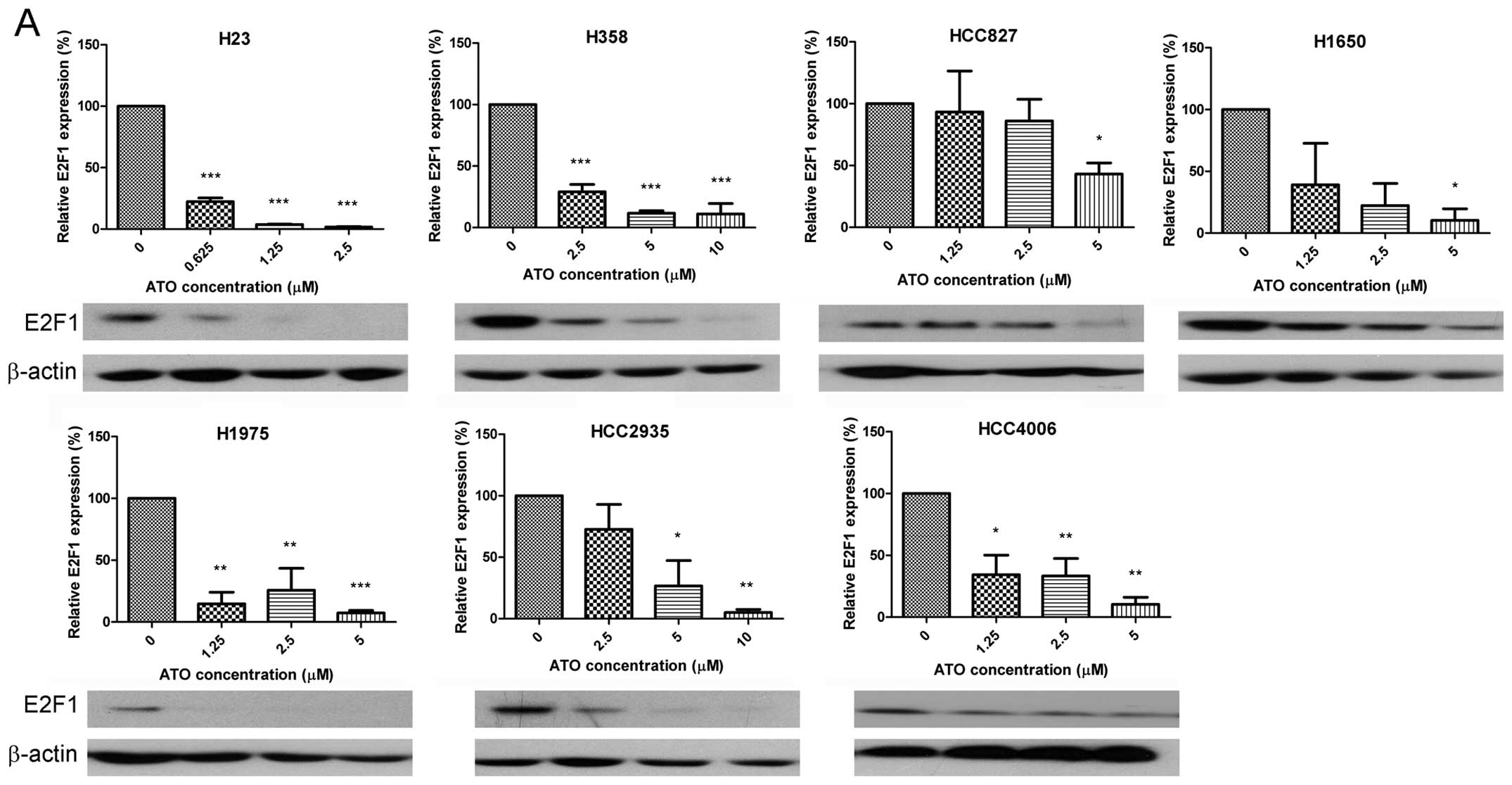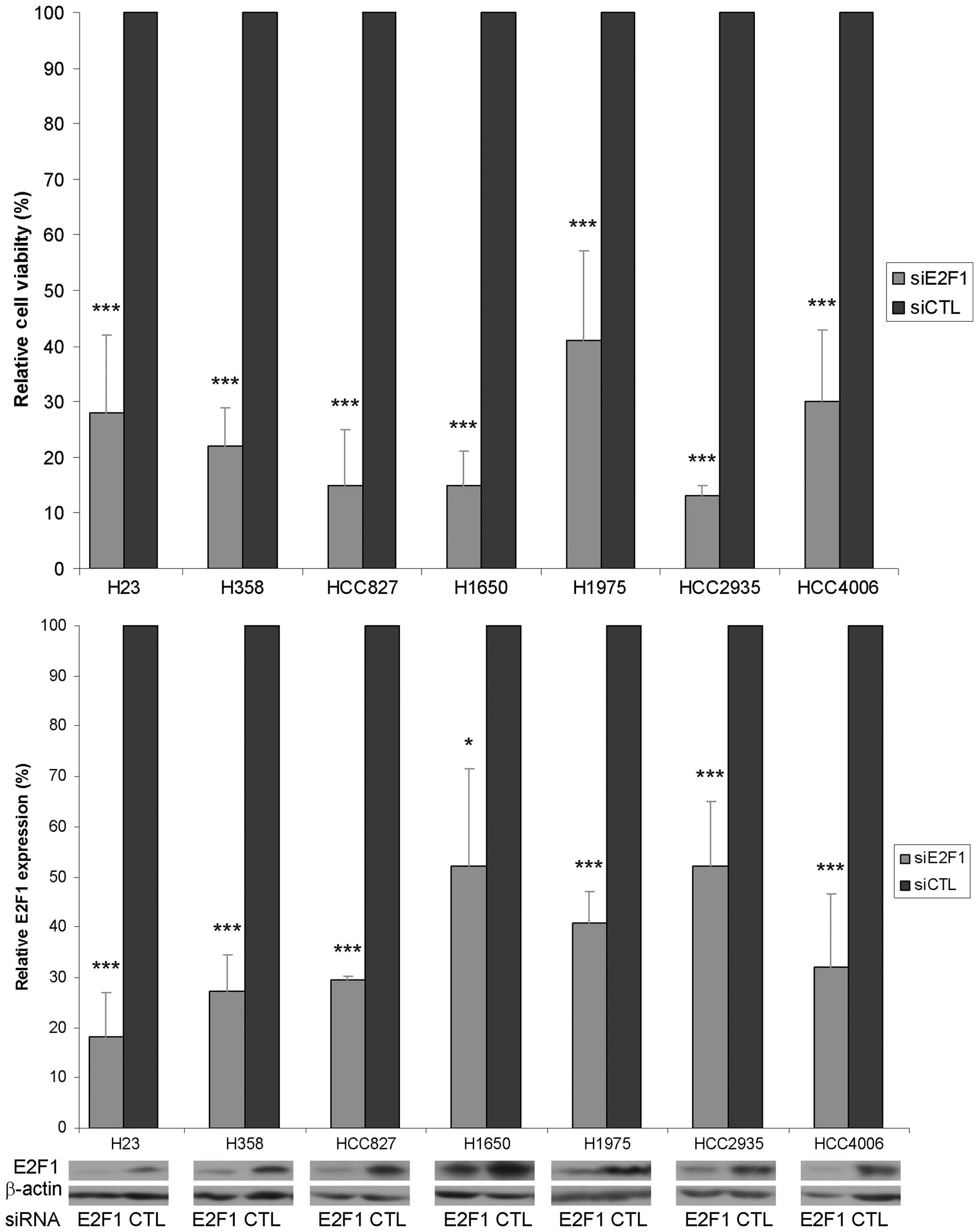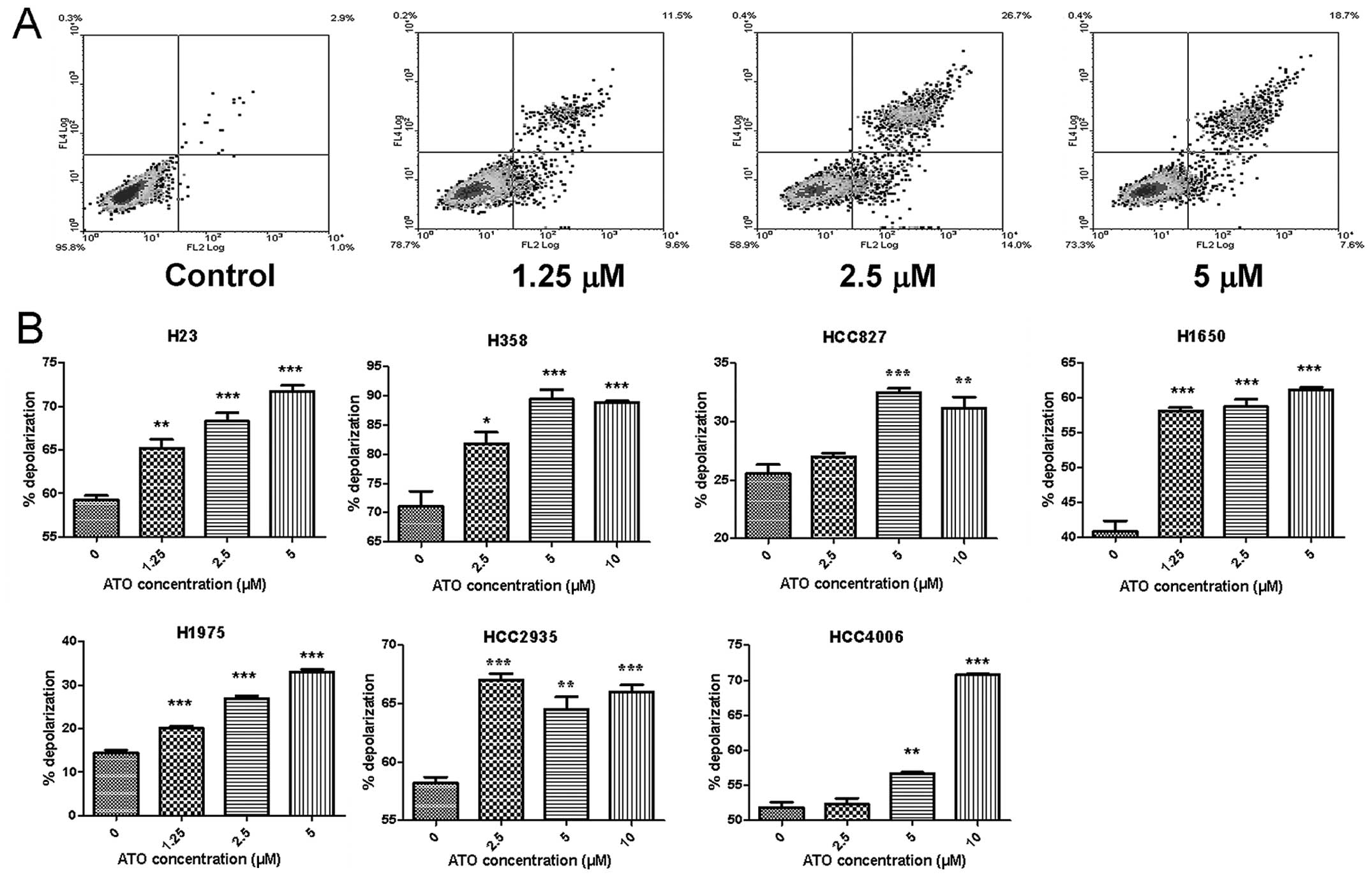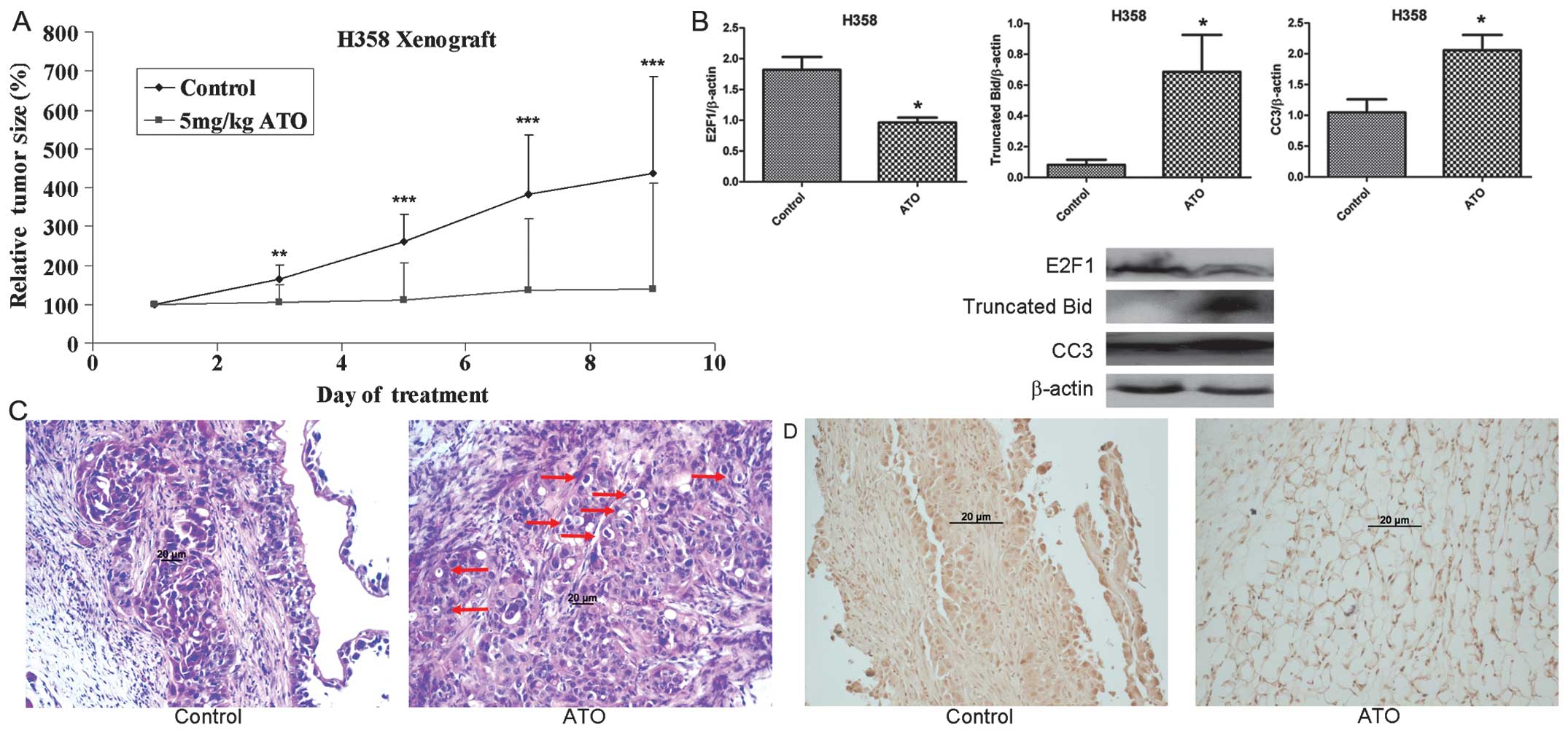|
1
|
Yano T, Haro A, Shikada Y, Maruyama R and
Maehara Y: Non-small cell lung cancer in never smokers as a
representative ‘non-smoking-associated lung cancer’: epidemiology
and clinical features. Int J Clin Oncol. 16:287–293. 2011.
|
|
2
|
Favaretto AG, Pasello G and Magro C:
Second and third line treatment in advanced non-small cell lung
cancer. Discov Med. 8:204–209. 2009.PubMed/NCBI
|
|
3
|
Goldstraw P, Crowley J, Chansky K, et al:
The IASLC Lung Cancer Staging Project: proposals for the revision
of the TNM stage groupings in the forthcoming (seventh) edition of
the TNM classification of malignant tumours. J Thorac Oncol.
2:706–714. 2007. View Article : Google Scholar
|
|
4
|
Suda K, Onozato R, Yatabe Y and Mitsudomi
T: EGFR T790M mutation: a double role in lung cancer cell survival?
J Thorac Oncol. 4:1–4. 2009. View Article : Google Scholar : PubMed/NCBI
|
|
5
|
Au WY, Kumana CR, Kou M, et al: Oral
arsenic trioxide in the treatment of relapsed acute promyelocytic
leukemia. Blood. 102:407–408. 2003. View Article : Google Scholar : PubMed/NCBI
|
|
6
|
Chien CW, Yao JH, Chang SY, Lee PC and Lee
TC: Enhanced suppression of tumor growth by concomitant treatment
of human lung cancer cells with suberoylanilide hydroxamic acid and
arsenic trioxide. Toxicol Appl Pharmacol. 257:59–66. 2011.
View Article : Google Scholar : PubMed/NCBI
|
|
7
|
Ghaffari SH, Momeny M, Bashash D, Mirzaei
R, Ghavamzadeh A and Alimoghaddam K: Cytotoxic effect of arsenic
trioxide on acute promyelocytic leukemia cells through suppression
of NFkbeta-dependent induction of hTERT due to down-regulation of
Pin1 transcription. Hematology. 17:198–206. 2012. View Article : Google Scholar : PubMed/NCBI
|
|
8
|
Han YH, Kim SZ, Kim SH and Park WH:
Arsenic trioxide inhibits the growth of Calu-6 cells via inducing a
G2 arrest of the cell cycle and apoptosis accompanied with the
depletion of GSH. Cancer Lett. 270:40–55. 2008. View Article : Google Scholar : PubMed/NCBI
|
|
9
|
Lam SK, Mak JC, Zheng CY, Li YY, Kwong YL
and Ho JC: Downregulation of thymidylate synthase with arsenic
trioxide in lung adenocarcinoma. Int J Oncol. 44:2093–2102.
2014.PubMed/NCBI
|
|
10
|
Slee EA and Lu X: Requirement for
phosphorylation of P53 at Ser312 in suppression of chemical
carcinogenesis. Sci Rep. 3:31052013.PubMed/NCBI
|
|
11
|
Tsantoulis PK and Gorgoulis VG:
Involvement of E2F transcription factor family in cancer. Eur J
Cancer. 41:2403–2414. 2005. View Article : Google Scholar : PubMed/NCBI
|
|
12
|
Huang CL, Liu D, Nakano J, et al: E2F1
overexpression correlates with thymidylate synthase and survivin
gene expressions and tumor proliferation in non small-cell lung
cancer. Clin Cancer Res. 13:6938–6946. 2007. View Article : Google Scholar : PubMed/NCBI
|
|
13
|
Gorgoulis VG, Zacharatos P, Mariatos G, et
al: Transcription factor E2F-1 acts as a growth-promoting factor
and is associated with adverse prognosis in non-small cell lung
carcinomas. J Pathol. 198:142–156. 2002. View Article : Google Scholar : PubMed/NCBI
|
|
14
|
Liontos M, Niforou K, Velimezi G, et al:
Modulation of the E2F1-driven cancer cell fate by the DNA damage
response machinery and potential novel E2F1 targets in
osteosarcomas. Am J Pathol. 175:376–391. 2009. View Article : Google Scholar : PubMed/NCBI
|
|
15
|
Li YY, Lam SK, Mak JC, Zheng CY and Ho JC:
Erlotinib-induced autophagy in epidermal growth factor receptor
mutated non-small cell lung cancer. Lung Cancer. 81:354–361. 2013.
View Article : Google Scholar : PubMed/NCBI
|
|
16
|
Kousparou CA, Yiacoumi E, Deonarain MP and
Epenetos AA: Generation of a selectively cytotoxic fusion protein
against p53 mutated cancers. BMC Cancer. 12:3382012. View Article : Google Scholar
|
|
17
|
Yamauchi KIY, Ogata K, Hara S, Tamura K,
Suzumiya J, Ishitsuka K and Ono N: Pharmacokinetics of arsenic
trioxide in Japanese patients with acute promyelocytic leukemia and
adult T-cell leukemia lymphoma. Jpn J Pharmaceut Health Care Sci.
30:492–496. 2004. View Article : Google Scholar
|
|
18
|
Chen GQ, Shi XG, Tang W, et al: Use of
arsenic trioxide (As2O3) in the treatment of
acute promyelocytic leukemia (APL): I. As2O3
exerts dose-dependent dual effects on APL cells. Blood.
89:3345–3353. 1997.PubMed/NCBI
|
|
19
|
Bustamante J, Nutt L, Orrenius S and
Gogvadze V: Arsenic stimulates release of cytochrome c from
isolated mitochondria via induction of mitochondrial permeability
transition. Toxicol Appl Pharmacol. 207:110–116. 2005.PubMed/NCBI
|
|
20
|
Momeny M, Zakidizaji M, Ghasemi R, et al:
Arsenic trioxide induces apoptosis in NB-4, an acute promyelocytic
leukemia cell line, through up-regulation of p73 via suppression of
nuclear factor kappa B-mediated inhibition of p73 transcription and
prevention of NF-kappaB-mediated induction of XIAP, cIAP2, BCL-XL
and survivin. Med Oncol. 27:833–842. 2010.
|
|
21
|
Meng R, Zhou J, Sui M, Li Z, Feng G and
Yang B: Arsenic trioxide promotes mitochondrial DNA mutation and
cell apoptosis in primary APL cells and NB4 cell line. Sci China
Life Sci. 53:87–93. 2010. View Article : Google Scholar : PubMed/NCBI
|
|
22
|
Baek JH, Moon CH, Cha SJ, et al: Arsenic
trioxide induces depolymerization of microtubules in an acute
promyelocytic leukemia cell line. Korean J Hematol. 47:105–112.
2012. View Article : Google Scholar : PubMed/NCBI
|
|
23
|
Worku D, Jouhra F, Jiang GW, Patani N,
Newbold RF and Mokbel K: Evidence of a tumour suppressive function
of E2F1 gene in human breast cancer. Anticancer Res. 28:2135–2139.
2008.PubMed/NCBI
|
|
24
|
Xu F, You X, Liu F, et al: The oncoprotein
HBXIP up-regulates Skp2 via activating transcription factor E2F1 to
promote proliferation of breast cancer cells. Cancer Lett.
333:124–132. 2013. View Article : Google Scholar : PubMed/NCBI
|
|
25
|
Onda M, Nagai H, Yoshida A, et al:
Up-regulation of transcriptional factor E2F1 in papillary and
anaplastic thyroid cancers. J Hum Genet. 49:312–318. 2004.
View Article : Google Scholar : PubMed/NCBI
|
|
26
|
Farra R, Dapas B, Pozzato G, et al:
Effects of E2F1-cyclin E1–E2 circuit down regulation in
hepatocellular carcinoma cells. Dig Liver Dis. 43:1006–1014.
2011.
|
|
27
|
Yamazaki K, Yajima T, Nagao T, et al:
Expression of transcription factor E2F-1 in pancreatic ductal
carcinoma: an immunohistochemical study. Pathol Res Pract.
199:23–28. 2003. View Article : Google Scholar : PubMed/NCBI
|
|
28
|
Yam CH, Fung TK and Poon RY: Cyclin A in
cell cycle control and cancer. Cell Mol Life Sci. 59:1317–1326.
2002. View Article : Google Scholar : PubMed/NCBI
|
|
29
|
Hilbe W, Dirnhofer S, Greil R and Woll E:
Biomarkers in non-small cell lung cancer prevention. Eur J Cancer
Prev. 13:425–436. 2004. View Article : Google Scholar : PubMed/NCBI
|
|
30
|
Ceppi P, Rapa I, Lo Iacono M, et al:
Expression and pharmacological inhibition of thymidylate synthase
and Src kinase in nonsmall cell lung cancer. Int J Cancer.
130:1777–1786. 2012. View Article : Google Scholar : PubMed/NCBI
|
|
31
|
Hung WC, Tseng WL, Shiea J and Chang HC:
Skp2 overexpression increases the expression of MMP-2 and MMP-9 and
invasion of lung cancer cells. Cancer Lett. 288:156–161. 2010.
View Article : Google Scholar : PubMed/NCBI
|
|
32
|
Huang ZH, Tian XS, Li R, et al: Elevated
thymidine kinase 1 in serum following neoadjuvant chemotherapy
predicts poor outcome for patients with locally advanced breast
cancer. Exp Ther Med. 3:331–335. 2012.
|
|
33
|
Wang L, Meng L, Wang XW, Ma GY and Chen
JH: Expression of RRM1 and RRM2 as a novel prognostic marker in
advanced non-small cell lung cancer receiving chemotherapy. Tumour
Biol. 35:1899–1906. 2014. View Article : Google Scholar : PubMed/NCBI
|
|
34
|
Ryu BJ, Hwang MK, Park M, Lee K and Kim
SH: Thiourea compound AW00178 sensitizes human H1299 lung carcinoma
cells to TRAIL-mediated apoptosis. Bioorg Med Chem Lett.
22:3862–3865. 2012. View Article : Google Scholar : PubMed/NCBI
|
|
35
|
Filomeni G, Turella P, Dupuis ML, et al:
6-(7-Nitro-2,1,3-benzoxadiazol-4-ylthio)hexanol, a specific
glutathione S-transferase inhibitor, overcomes the multidrug
resistance (MDR)-associated protein 1-mediated MDR in small cell
lung cancer. Mol Cancer Ther. 7:371–379. 2008. View Article : Google Scholar
|
|
36
|
Walker T, Nolte A, Steger V, et al: Small
interfering RNA-mediated suppression of serum response factor,
E2-promotor binding factor and survivin in non-small cell lung
cancer cell lines by non-viral transfection. Eur J Cardiothorac
Surg. 43:624–633. 2013.
|
|
37
|
Hu T, Shi J, Jiao X, Zhou J and Yin X:
Measurement of Annexin V uptake and lactadherin labeling for the
quantification of apoptosis in adherent Tca8113 and ACC-2 cells.
Braz J Med Biol Res. 41:750–757. 2008. View Article : Google Scholar : PubMed/NCBI
|
|
38
|
Korper S, Nolte F, Thiel E, Schrezenmeier
H and Rojewski MT: The role of mitochondrial targeting in arsenic
trioxide-induced apoptosis in myeloid cell lines. Br J Haematol.
124:186–189. 2004. View Article : Google Scholar : PubMed/NCBI
|
|
39
|
Shen ZY, Shen J, Cai WJ, Hong C and Zheng
MH: The alteration of mitochondria is an early event of arsenic
trioxide induced apoptosis in esophageal carcinoma cells. Int J Mol
Med. 5:155–158. 2000.PubMed/NCBI
|
|
40
|
Wang Y, Xu Y, Wang H, et al: Arsenic
induces mitochondria-dependent apoptosis by reactive oxygen species
generation rather than glutathione depletion in Chang human
hepatocytes. Arch Toxicol. 83:899–908. 2009. View Article : Google Scholar
|
|
41
|
Xu Y, Wang H, Wang Y, Zheng Y and Sun G:
Effects of folate on arsenic toxicity in Chang human hepatocytes:
involvement of folate antioxidant properties. Toxicol Lett.
195:44–50. 2010. View Article : Google Scholar : PubMed/NCBI
|
|
42
|
Jin HO, Seo SK, Woo SH, et al: A
combination of sulindac and arsenic trioxide synergistically
induces apoptosis in human lung cancer H1299 cells via c-Jun
NH2-terminal kinase-dependent Bcl-xL phosphorylation. Lung Cancer.
61:317–327. 2008. View Article : Google Scholar
|
|
43
|
Jin HO, Yoon SI, Seo SK, et al:
Synergistic induction of apoptosis by sulindac and arsenic trioxide
in human lung cancer A549 cells via reactive oxygen
species-dependent down-regulation of survivin. Biochem Pharmacol.
72:1228–1236. 2006. View Article : Google Scholar : PubMed/NCBI
|
|
44
|
Qin DB, Chen JP and Wang SQ: Mechanism of
apoptosis of NB4 cells induced by arsenic trioxide and
cyclooxygenase-2 expression. Zhongguo Shi Yan Xue Ye Xue Za Zhi.
19:648–651. 2011.(In Chinese).
|
|
45
|
Su Y, Wang X, Xu W, et al: Arsenic
trioxide increases the sensitivity of 786–0 renal carcinoma cells
to radiotherapy. Cancer Invest. 30:114–118. 2012.PubMed/NCBI
|
|
46
|
Tung JN, Cheng YW, Hsu CH, et al:
Normoxically overexpressed hypoxia inducible factor 1-alpha is
involved in arsenic trioxide resistance acquisition in
hepatocellular carcinoma. Ann Surg Oncol. 18:1492–1500. 2011.
View Article : Google Scholar
|
|
47
|
Li HC, Wang CX, Huang C, et al: Effect and
mechanism of arsenic trioxide on chemosensitivity of human lung
adenocarcinoma cells. Zhonghua Jie He He Hu Xi Za Zhi. 26:689–692.
2003.(In Chinese).
|
|
48
|
Shi Y, Liu Y, Huo J and Gao G: Arsenic
trioxide induced apoptosis and expression of p53 and bcl-2 genes in
human small cell lung cancer cells. Zhonghua Jie He He Hu Xi Za
Zhi. 25:665–666. 2002.PubMed/NCBI
|
|
49
|
Pettersson HM, Pietras A, Munksgaard
Persson M, et al: Arsenic trioxide is highly cytotoxic to small
cell lung carcinoma cells. Mol Cancer Ther. 8:160–170. 2009.
View Article : Google Scholar : PubMed/NCBI
|
|
50
|
Yuan Z, Wang F, Zhao Z, et al:
BIM-mediated AKT phosphorylation is a key modulator of arsenic
trioxide-induced apoptosis in cisplatin-sensitive and -resistant
ovarian cancer cells. PLoS One. 6:e205862011. View Article : Google Scholar : PubMed/NCBI
|
|
51
|
Potin S, Bertoglio J and Breard J:
Involvement of a Rho-ROCK-JNK pathway in arsenic trioxide-induced
apoptosis in chronic myelogenous leukemia cells. FEBS Lett.
581:118–124. 2007. View Article : Google Scholar : PubMed/NCBI
|
|
52
|
Walker AM, Stevens JJ, Ndebele K and
Tchounwou PB: Arsenic trioxide modulates DNA synthesis and
apoptosis in lung carcinoma cells. Int J Environ Res Public Health.
7:1996–2007. 2010. View Article : Google Scholar
|
|
53
|
Bairey O, Vanichkin A and Shpilberg O:
Arsenic-trioxide-induced apoptosis of chronic lymphocytic leukemia
cells. Int J Lab Hematol. 32:e77–85. 2010. View Article : Google Scholar : PubMed/NCBI
|
|
54
|
Cheng Y, Chang LW and Tsou TC:
Mitogen-activated protein kinases mediate arsenic-induced
down-regulation of survivin in human lung adenocarcinoma cells.
Arch Toxicol. 80:310–318. 2006. View Article : Google Scholar
|
|
55
|
Luo M, Lu Z, Sun H, et al: Nuclear entry
of active caspase-3 is facilitated by its p3-recognition-based
specific cleavage activity. Cell Res. 20:211–222. 2010. View Article : Google Scholar : PubMed/NCBI
|














